Madlener House
4 West Burton Place
Chicago, Illinois 60610
Telephone: 312.787.4071
info@grahamfoundation.org
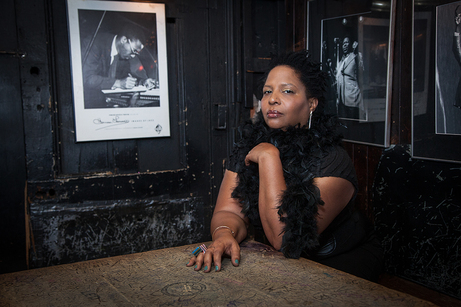
The workshop focuses on building confidence from within and without. It asks how do we see ourselves and how we can help others see us in beneficial ways. Workshop leader Fay Victor—a New York-based sound artist and composer—leads exercises, demonstrations, and discussions in the service of being seen. RSVP is required and space is limited.
Fay Victor, called “artistically complete” by the New York Times, hones a unique vision for the vocalist's role in jazz and improvised music. Victor’s recorded work has been featured in media outlets such as The Wall Street Journal, The San Francisco Chronicle, Time Out New York, and The Huffington Post. Victor has performed with luminaries such as Randy Weston, Roswell Rudd, Nicole Mitchell, Archie Shepp, Marc Ribot, and Tyshawn Sorey. Performance highlights include those at The Museum of Modern Art (New York), Hammer Museum (Los Angeles), Kölner Philharmonie (Germany), De Young Museum (San Francisco), Symphony Space (New York), and Bimhuis (Netherlands). Victor was the 2017 Herb Albert/Yaddo Fellow in Music Composition. Current releases include her album Wet Robots (ESP Disk, July 2018) with her SoundNoiseFUNK project, Nicole Mitchell’s Maroon Cloud (FPE Records, August 2018), and Marc Ribot’s upcoming Songs of Resistance (September 2018) featuring Victor as well as guests vocalists Tom Waits, Steve Earle, and Meshell Ndegeocello.
Image: Fay Victor. Photo: Richard Koek
For more information on the exhibition, Incense Sweaters & Ice, click here.
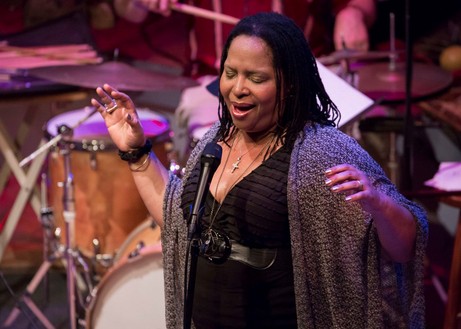
Image: Fay Victor by Eva Kapanzade
Presenting a talk, musical performance, and a question and answer session, New York-based sound artist and composer, Fay Victor utilizes music as a vehicle to express thoughts and sounds in a multigenre universe that reflects identity, new music, jazz, blues, house, funk, and free improvisation—recalling references from jazz legend Albert Ayler to the innovative Frank Zappa. In partnership with Chicago-based musician Mike Reed, the two explore message together through jazz.
Fay Victor, called “artistically complete” by the New York Times, hones a unique vision for the vocalist's role in jazz and improvised music. Victor’s recorded work has been featured in media outlets such as The Wall Street Journal, The San Francisco Chronicle, Time Out New York, and The Huffington Post. Victor has performed with luminaries such as Randy Weston, Roswell Rudd, Nicole Mitchell, Archie Shepp, Marc Ribot, and Tyshawn Sorey. Performance highlights include those at The Museum of Modern Art (New York), Hammer Museum (Los Angeles), Kölner Philharmonie (Germany), De Young Museum (San Francisco), Symphony Space (New York), and Bimhuis (Netherlands). Victor was the 2017 Herb Albert/Yaddo Fellow in Music Composition. Current releases include her album Wet Robots (ESP Disk, July 2018) with her SoundNoiseFUNK project, Nicole Mitchell’s Maroon Cloud (FPE Records, August 2018), and Marc Ribot’s upcoming Songs of Resistance (September 2018) featuring Victor as well as guests vocalists Tom Waits, Steve Earle, and Meshell Ndegeocello.
Mike Reed is a musician, composer, bandleader and arts presenter based in Chicago. In addition to leading or co-leading several working bands, all rooted deeply in jazz and improvised music, he’s the current programming chair of the Chicago Jazz Festival, and the owner and director of the acclaimed performing arts venue Constellation.
Image: Fay Victor. Photo: Richard Koek
For more information on the exhibition, Incense Sweaters & Ice, click here.
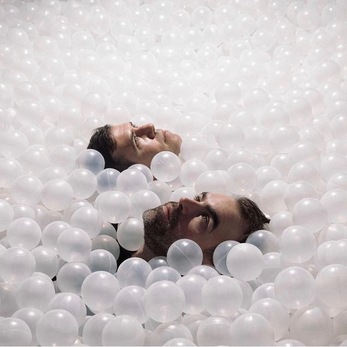
Join us for a talk by Alex Mustonen and Benjamin Porto of the New York-based collaborative design practice Snarkitecture. This event will take place in advance of the unveiling of The Beach, a large-scale interactive installation that will open to the public on Saturday, January 19 in the Aon Grand Ballroom at Navy Pier. Snarkitecture’s work focuses on the reinterpretation of everyday materials within a conceptual approach to create unexpected engagements with our surroundings — centered on the importance of experience, this premise extends to The Beach, an all-white ocean of over one million recyclable, antimicrobial plastic balls.
Following the talk, the bookshop will host a book signing of Snarkitecture’s recent catalogue, published by Phaidon.
Snarkitecture is a New York-based collaborative design practice established to investigate the boundaries between disciplines. The name is drawn from Lewis Carroll’s The Hunting of The Snark, a poem describing the “impossible voyage of an improbable crew to find an inconceivable creature.” In its search for the unknown, Snarkitecture creates work that includes large-scale projects, installations and objects.
This talk is presented in partnership with EXPO CHICAGO and Navy Pier. For more information about the upcoming installation The Beach at the Aon Grand Ballroom at Navy Pier click here.
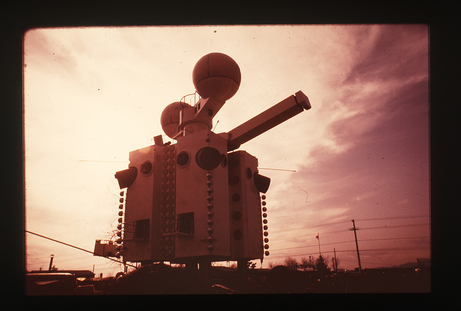
Arata Isozaki, DEME robot, 1970
Containing a wealth of texts and images, Thomas Daniell’s Graham-funded book An Anatomy of Influence elucidates the theory and practice of 12 leading Japanese architects (Hiromi Fujii, Terunobu Fujimori, Hiroshi Hara, Itsuko Hasegawa, Osamu Ishiyama, Arata Isozaki, Toyo Ito, Kengo Kuma, Kazuyo Sejima, Kazuo Shinohara, Shin Takamatsu, and Kiyoshi Sey Takeyama). Rather than the usual array of exquisite yet autonomous buildings, this newly released publication focuses on the hitherto unexplored lives of their architects, and the intellectual, social, and political environment in which they worked. The result is not only a fascinating perspective on modern Japanese architecture, but a profound recasting of our understanding of the modern Japanese architect.
Thomas Daniell is a Professor of Architectural Theory and Criticism at Kyoto University, Japan. A two-time recipient of publication grants from the Graham Foundation, his latest book is An Anatomy of Influence (AA Publications, 2018). His previous books include FOBA: Buildings (Princeton Architectural Press, 2005), After the Crash: Architecture in Post-Bubble Japan (Princeton Architectural Press, 2008), Houses and Gardens of Kyoto (Tuttle, 2010), Kiyoshi Sey Takeyama + Amorphe (Equal Books, 2011), and Kansai 6 (Equal Books, 2011).
Related Graham Foundation supported projects:
2015 Publication grant to Thomas Daniell for An Anatomy of Influence
2008 Publication grant to Thomas Daniell for After the Crash: Architecture in Post-Bubble Japan
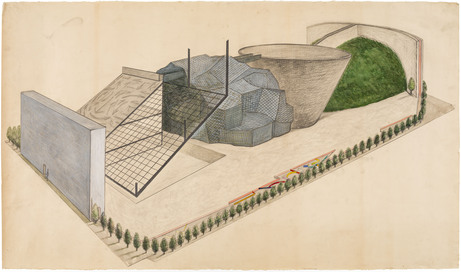
5:30 p.m. Comments by curator Irene Sunwoo; Stephen Hepworth, director of collections at the Reversible Destiny Foundation; and exhibition designers Carrie Norman and Thomas Kelley
6:00–8:00 p.m. Opening reception
Please join us for a reception and introductory remarks by exhibition curator Irene Sunwoo; Stephen Hepworth, director of collections at the Reversible Destiny Foundation; and exhibition designers Carrie Norman and Thomas Kelley to celebrate the opening of our winter exhibition.
Eternal Gradient traces the emergence of architecture as a wellspring of creativity and theoretical exploration for the artist Arakawa (1936–2010) and poet and philosopher Madeline Gins (1941–2014). Including over 40 drawings and a wide-range of archival materials, this presentation illuminates a pivotal moment within a collaborative practice that spanned nearly five-decades.
Eternal Gradient originated at the Arthur Ross Architecture Gallery at Columbia University Graduate School of Architecture, Planning and Preservation (GSAPP) and is made possible, in part, by the Estate of Madeline Gins and through a partnership with the Reversible Destiny Foundation.
The exhibition was curated by Irene Sunwoo, GSAPP director of exhibitions and curator of the Arthur Ross Architecture Gallery, with Tiffany Lambert, GSAPP assistant director of exhibitions. The Graham Foundation presentation is organized by Sarah Herda, director, and Ellen Alderman, deputy director of exhibitions and public programs. The exhibition design is by Norman Kelley, a Chicago & New Orleans architecture and design collective founded by Carrie Norman and Thomas Kelley.
Image: Arakawa and Madeline Gins, Drawing for ‘Container of Perceiving,’ 1984. Acrylic, watercolor and graphite on paper. 42 1/2 x 72 3/4 in. Photo: Nicholas Knight. Courtesy Columbia GSAPP. © 2018 Estate of Madeline Gins. Reproduced with permission of the Estate of Madeline Gins
For more information on the exhibition, Eternal Gradient , click here.
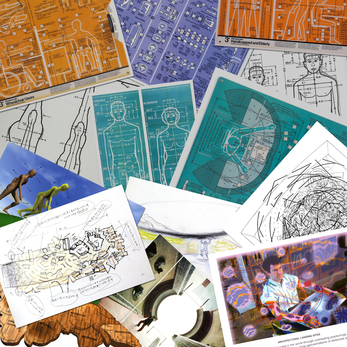
The work of Arakawa and Madeline Gins is usually approached through art theory, philosophy, or even sciences; yet, rarely is it examined through the underlying, yet powerful, political dimension of their groundbreaking work. This presentation will first attempt to demonstrate how all designs are calibrated on a certain idea of what a body is, almost always reinforcing societal normativity and its violence in doing so. It will then illustrate the ways through which Arakawa and Gins designed architectural projects that fundamentally subvert such normativity and, as such, can be read as one of the rare examples of revolutionary political architecture.
Léopold Lambert is a Paris-based, trained architect who collaborated with Madeline Gins in 2013–14. He is the editor-in-chief of the print and online magazine The Funambulist, dedicated to the politics of space and bodies. He is the author of Weaponized Architecture: The Impossibility of Innocence (DPR-Barcelona, 2012); Topie Impitoyable: The Corporeal Politics of the Cloth, the Wall, and the Street (Punctum Books, 2015); La politique du bulldozer: La ruine palestinienne comme projet israélien (Éditions B2, 2016); and States of Emergency: A Spatial History of the French Colonial Continuum (forthcoming, 2019). He has been the recipient of four Graham Foundation grants between 2014 and 2017.
Related Graham Foundation supported projects:
2017 publication grant to Léopold Lambert for The Funambulist
2016 publication grant to Léopold Lambert for The Funambulist
2015 new media grant to Léopold Lambert for The Funambulist Podcast
2014 new media grant to Léopold Lambert for The Funambulist Podcast
Image caption: Léopold Lambert, Human Engineering vs. Arakawa+Gins, collage, 2019
For more information on the exhibition, Eternal Gradient , click here.
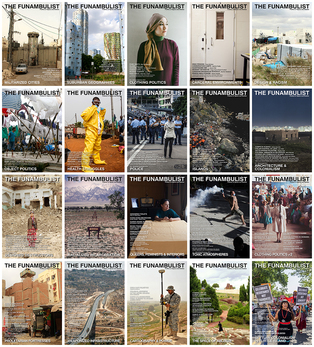
The Funambulist is a magazine that believes that the politics of its production and management should be held to the same standards as the politics of its contents. In this regard, and although self-critique is always challenging, this presentation examines how the magazine meets and fails this mission. Graham grantee Léopold Lambert reflects on the work to date and presents future directions for the publication.
Léopold Lambert is a Paris-based, trained architect who collaborated with Madeline Gins in 2013–14. He is the editor-in-chief of the print and online magazine The Funambulist, dedicated to the politics of space and bodies. He is the author of Weaponized Architecture: The Impossibility of Innocence (DPR-Barcelona, 2012); Topie Impitoyable: The Corporeal Politics of the Cloth, the Wall, and the Street (Punctum Books, 2015); La politique du bulldozer: La ruine palestinienne comme projet israélien (Éditions B2, 2016); and States of Emergency: A Spatial History of the French Colonial Continuum (forthcoming, 2019). He has been the recipient of four Graham Foundation grants between 2014 and 2017.
Related Graham Foundation supported projects:
2017 Publication grant to Léopold Lambert for The Funambulist
2016 Publication grant to Léopold Lambert for The Funambulist
2015 New Media grant to Léopold Lambert for The Funambulist Podcast
2014 New Media grant to Léopold Lambert for The Funambulist Podcast
Image caption: The 20 first issues of The Funambulist since September 2015
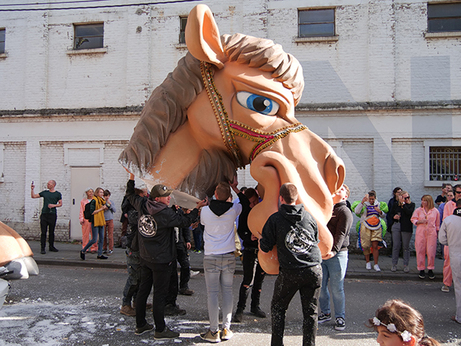
At the midpoint of their unfolding series of exhibitions, Atlas Unlimited (supported by a 2018 Graham Foundation Grant to Individuals), artist Karthik Pandian and choreographer Andros Zins-Browne present “Entr’acte,” a lecture in the presence of an object. The lecture, delivered by archaeologist Dr. Tasha K. Vorderstrasse (Oriental Institute, Chicago) concerns a fragment of a sculpture found in the ancient Syrian city of Palmyra. Installed in the Madlener House for one night only, the object will rest on a base that the artists have produced in collaboration with Chicago-based furniture designer Casey Lurie. “Entr’acte” is presented concurrently with Pandian and Zins-Browne’s solo exhibition, Atlas Unlimited (Acts V-VI), at the Logan Center for the Arts at the University of Chicago, which runs from February 1–March 17, 2019. “Entr’acte” is produced in collaboration with emerging Syrian theater-maker, Sami Ismat.
American artist Karthik Pandian has held solo exhibitions at the Whitney Museum of American Art; Bétonsalon, Paris; Midway Contemporary Art, Minneapolis; and White Flag Projects, St. Louis, amongst others. His work was featured in the inaugural Made in L.A. at the Hammer Museum and La Triennale: Intense Proximity at the Palais de Tokyo as well as in group exhibitions such as Adventures of the Black Square: Abstract Art and Society 1915–-–2015 at Whitechapel Gallery; Film as Sculpture at Wiels Contemporary Art Centre, Brussels; and the 4th Marrakech Biennial, Higher Atlas. Pandian holds an MFA from Art Center College of Design and a BA from Brown University. He lives and works in Cambridge, Massachusetts where he teaches video, sculpture, and performance at Harvard University.
Andros Zins-Browne is an American choreographer who lives in Brussels and New York City. After receiving a degree in Art Semiotics from Brown University, he went on to study dance at PARTS in Brussels and in the fine arts department of the Jan van Eyck Academy in Maastricht. Zins-Browne's performances cross between stage and exhibition spaces including: Centre Pompidou Paris; ICA London; HAU Berlin; Stedelijk Museum Amsterdam; DeSingel Antwerp; EMPAC, Troy, NY; Kaaitheater Brussels; and the Impulse Festival, Düsseldorf where he received the Goethe Institute Award for The Host. His solo Already Unmade, a commission by The Boghossian Foundation, has recently been performed at the BOZAR Museum, Brussels; The Whitney Museum of American Art, in New York City; the Rockbund Art Museum, Shanghai; and Lafayette Anticipations, Paris.
Sami Ismat is a theatre and performance maker from Damascus, Syria currently living in Chicago as a refugee.
Casey Lurie is an independent designer based in Chicago.
Tasha Vorderstrasse is a Near Eastern archaeologist who focuses on questions of cultural identity and exchange.
Special thanks to builder Anthony Adcock
Related Graham Foundation supported projects:
2018 exhibition grant to Karthik Pandian & Andros Zins-Browne for Atlas Unlimited (Acts V—VI) at the Logan Center for the Arts at the University of Chicago, February 1–March 17, 2019
Image: Karthik Pandian and Andros Zins-Browne with De Looizemaanen, Atlas Unlimited Act I: Carnaval, Netwerk Aalst. Photo: Karthik Pandian
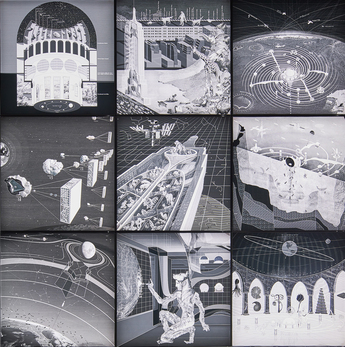
Satellite Citizens brings together Dimensions of Citizenship participants and catalog essayists to discuss the past, present, and future of technology and space exploration. Who is excluded and included when we gaze upward to the cosmos or delve deep into the network? Panelists include writer Ingrid Burrington, Rania Ghosn and El Hadi Jazairy of the collaborative practice Design Earth, and Fred Scharmen. Moderated by Jonathan Solomon, director of the Department of Architecture, Interior Architecture, and Designed Objects at School of the Art Institute of Chicago (SAIC).
This event is presented concurrently with the Chicago presentation of the Graham funded exhibition Dimensions of Citizenship: Architecture and Belonging from the Body to the Cosmos, a reinstallation of the official US Pavilion at the 16th International Architecture Exhibition of the Venice Biennale, at Wrightwood 659, which runs from February 28 through April 27, 2019.
Ingrid Burrington writes about the Internet, politics, and art, and has been published in The Atlantic, The Nation, ProPublica, San Francisco Art Quarterly, Dissent, and elsewhere. She’s given talks at conferences both in the US and abroad, and her art has been exhibited in galleries in New York, Tokyo, Leipzig, Baltimore, Philadelphia, and many other cities.
Led by Rania Ghosn and El Hadi Jazairy, Design Earth examines the geographies of urban systems—such as energy, trash, water, and agriculture—to prompt the debate on the techno-environment in the age of climate change. The design research practice has exhibited its works at the Venice Biennale and other leading international architecture events and has received numerous accolades, including the Young Architects Prize from the Architectural League of New York. Their After Oil project was collected by The Museum of Modern Art. Ghosn and Jazairy each hold Doctor of Design degrees from the Harvard Graduate School of Design, where they founded the journal New Geographies and were the respective editors for NG2: Landscapes of Energy and NG4: Scales of the Earth. They have authored numerous books, including the Graham Foundation grant-supported Geostories (Actar, 2018) and Geographies of Trash (Actar, 2015) as well as recent essays and projects published in Domus, Journal of Architectural Education, Avery Review, and Perspecta, among others. Ghosn is Associate Professor of Architecture and Urbanism at the Massachusetts Institute of Technology’s School of Architecture + Planning, and Jazairy is Assistant Professor of Architecture at the University of Michigan’s Taubman College of Architecture and Urban Planning.
Fred Scharmen teaches architecture and urban design at Morgan State University's School of Architecture and Planning. His work as a designer and researcher is about how architects imagine new spaces for new speculative future worlds, and about who is invited into those worlds. His most recently completed projects, with the Working Group on Adaptive Systems, include a mile-and-a-half long scale model of the solar system in downtown Baltimore (in collaboration with nine artists who made the planets), and a pillow fort for the Baltimore Museum of Art, based on Gottfried Semper's Four Elements of Architecture. His writing has been published in the Journal of Architectural Education, Log, CLOG, Volume, and Domus. His architectural criticism has appeared in the Architect’s Newspaper, and in the local alt-weekly Baltimore City Paper.
Jonathan Solomon is associate professor and director of Architecture, Interior Architecture, and Designed Objects at the School of the Art Institute of Chicago. His drawings, analytical and counterfactual urban narratives, appear in Cities Without Ground (ORO, 2012), and 13 Projects for the Sheridan Expressway (PAPress, 2004). Solomon edits Forty-Five, a journal of outside research, and was curator of the US Pavilion at the 2010 Venice Architecture Biennale. His interests include extra-disciplinary, post-growth, and nonanthroponormative design futures. Solomon received a BA from Columbia University and an MArch from Princeton University and is a licensed architect in the State of Illinois.
Related Graham Foundation supported projects:
2017 grant to Rania Ghosn and El Hadi Jazairy for the publication Geostories
Image: Cosmorama by Design Earth at the 2018 U.S. Pavilion. Photo © Tom Harris. Courtesy of the School of the Art Institute of Chicago and the University of Chicago.
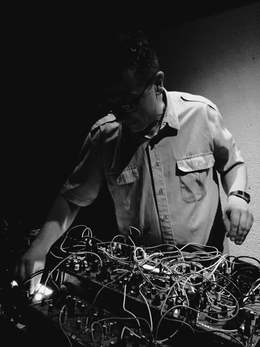
Pita is Peter Rehberg. In this performance—his first US solo date in more than a decade—he offers a semi-improvised electronic music concert with a new modular set-up.
Peter Rehberg (b.1968, London) cofounded the influential Mego label in 1994 and soon after began recording under the name Pita. His first solo release, Seven Tons for Free, came out in 1996, melding noise with techno. Since then he has produced over a dozen albums, covering an astonishing variety of experimental electronic styles. The Get Out / Get Down / Get Off trilogy received broad international critical acclaim and helped define the radical underground experimental electronic scene of the 1990s. He has played numerous concerts all over the world, including SONAR, ATP, CTM Berlin, MUTEK, Donaufestival, Le Guess Who?, and Atonal. In 1999 he won the Prix Ars Electronica for Digital Musics & Sound Art. In addition to his solo work, he is best known for long term collaborations with Stephen O’Malley, as KTL, and with Jim O’Rourke and Christian Fennesz as Fenn O’Berg. He also runs the groundbreaking label, Editions Mego, which has released albums by artists such as Hecker, Mark Fell, Fennesz, and Kevin Drumm.
In May 2009 Rehberg performed at Lampo with Marcus Schmickler. He also appeared at Lampo in March 2003, when he premiered Get Off.
Since 2010 the Graham Foundation has supported and partnered with Lampo to produce this performance series held at the Madlener House. Lampo, founded in 1997, is a non-profit organization for experimental music and intermedia projects.
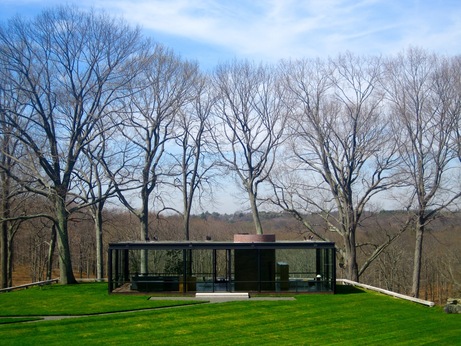
Most people in the design world know Philip Johnson, or think they do: He was the controversial architect with the round glasses who built a glass house and gave us the chippendale-capped AT&T Building in New York. But who, really, was he? In the course of his long life, he had a series of careers—curator, critic, journalist, politician—of which architect was only one. He was intellectually peripatetic. His buildings ranged widely in style and quality. How did he become this way? Who exactly was this complex man? Johnson biographer and Graham grantee Mark Lamster will talk about the process of figuring out Johnson, and putting that story into narrative form for his new book, The Man in the Glass House: Philip Johnson, Architect of the Modern Century.
Mark Lamster is the architecture critic of the Dallas Morning News and a professor at the architecture school of the University of Texas at Arlington. In 2017, he was a Loeb Fellow at the Harvard Graduate School of Design. His writing has appeared in The New York Times, the Los Angeles Times and The Wall Street Journal, and he is a regular contributor to numerous magazines.
Related Graham Foundation supported projects:
2010 research grant to Mark Lamster for Philip Johnson: A Biography
Image: The Glass House, in New Canaan, CT
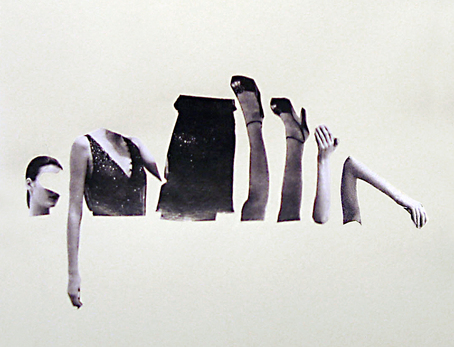
The starting point for Vlatka Horvat’s performance Third Hand is a collection of scenes, images, and moments that other artists and writers have recounted to her from memory. Responding to this unruly catalogue of vivid fragments, all of which focus on the performing body, Horvat creates a work that is somewhere between collage, animated archive, partial reenactment, and memory palace. Third Hand explores the ways in which performance lingers despite the processes of distortion, displacement, and erasure which take place in memory and over time, and which are amplified through the act of narration.
The human body summoned in Third Hand is a problematic, transforming, and misremembered one—mistaken for animal, ghost, object, or machine; hesitant and determined; exhausted and persisting; ecstatic, working, resting, and playing, as it is made and remade in language and in the moment of performance.
Work in progress developed and performed with Michael Thomas.
Vlatka Horvat works across a wide range of forms, including sculpture, installation, drawing, performance, photography, and writing. Her work is presented internationally in a variety of contexts—in museums and galleries, theater and dance festivals, and in public space. Recent exhibitions include: Croatian national Pavilion at the 16th Architecture Biennale, Museums Sheffield, Renata Fabbri Gallery (Milan), Eastwards Prospectus (Bucharest), Museum of Contemporary Art Zagreb, Bard Center for Curatorial Studies (upstate NY), Wilfried Lentz Gallery (Rotterdam), CAPRI (Düsseldorf). Her performances have been commissioned and presented by venues across Europe, North America, and beyond, including HAU – Hebbel am Ufer (Berlin), LIFT – London International Festival of Theatre, PACT Zollverein (Essen), Tanzquartier Wien (Vienna), Outpost for Contemporary Art (LA), and many others. Born in what used to be Yugoslavia, Horvat moved to the US as a teenager. After 20 years in the States, she currently lives in London, where she teaches in the Fine Art department at Central St Martins, University of the Arts London.
IN>TIME is Chicago’s triannual winter-long performance festival. The IN>TIME Festival features a season of performances, presentations, and exhibitions at venues throughout the city from local, national, and international artists.
Image: courtesy of the artist
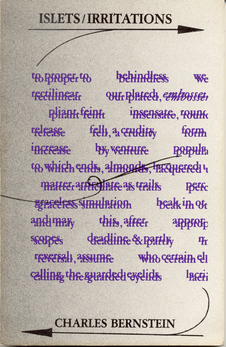
Charles Bernstein is the recipient of 2019 Bollingen Prize for American Poetry, the premier prize for lifetime achievement in poetry, administered by Yale University. He will read poems from Near/Miss (University of Chicago Press, 2018), honored by the prize, and more recent work. Presented in relationship to the exhibition Eternal Gradient, Bernstein will also read works in response to Arakawa and Madeline Gins’ work, reflecting his decades-long friendship with the artists.
This event is presented in partnership with the Poetry Foundation.
Charles Bernstein is the author of Near/Miss (University of Chicago Press, 2018), Pitch of Poetry (Chicago, 2016), Recalculating (Chicago, 2013) and Attack of the Difficult Poems: Essays and Inventions (Chicago, 2011). In 2010, Farrar, Straus & Giroux published All the Whiskey in Heaven: Selected Poems. Bernstein is Donald T. Regan Professor of English and Comparative Literature at the University of Pennsylvania, where he is codirector of PennSound. He is a fellow of the American Academy of Arts and Sciences.
The Poetry Foundation, publisher of Poetry magazine, is an independent literary organization committed to a vigorous presence for poetry in our culture. It exists to discover and celebrate the best poetry and to place it before the largest possible audience.
Image: Arakawa’s cover for Bernstein’s book Islets/Irritations, (New York: Jordan Davies, 1983)
For more information on the exhibition, Eternal Gradient , click here.
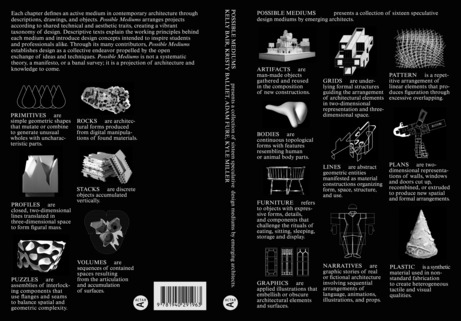
Join us for a panel discussion to launch the recently published Graham funded book Possible Mediums. The editors Kelly Bair, Kristy Balliet, Adam Fure, and Kyle Miller will present the Possible Mediums book and will be joined in discussion by Zoë Ryan.
Possible Mediums presents a collection of sixteen speculative design mediums by emerging architects. Each chapter defines an active medium in contemporary architecture through descriptions, drawings, and objects. Possible Mediums arranges projects according to shared technical and aesthetic traits, creating a vibrant taxonomy of design. Descriptive texts explain the working principles behind each medium and introduce design concepts intended to inspire students and professionals alike. Through its many contributors, Possible Mediums establishes design as a collective endeavor propelled by the open exchange of ideas and techniques. Possible Mediums is not a systematic theory, a manifesto, or a banal survey; it is a projection of architecture and knowledge to come.
Kelly Bair is Partner of BairBalliet, Director of Graduate Studies and Associate Professor at University of Illinois at Chicago School of Architecture.
Kristy Balliet is Partner of BairBalliet and Faculty at Southern California Institute of Architecture.
Adam Fure is Principal of T+E+A+M and Assistant Professor at University of Michigan Taubman College of Architecture and Urban Planning.
Kyle Miller is an Assistant Professor at Syracuse University School of Architecture.
Zoë Ryan is the John H. Bryan Chair and Curator of Architecture and Design at the Art Institute of Chicago. A curator and author, her projects focus on exploring the impact of architecture and design on society.
Related Graham supported projects:
2018 grant to Kelly Bair, Kristy Balliet, Adam Fure, and Kyle Miller for the publication Possible Mediums
Image: Cover of Possible Mediums, 2018.
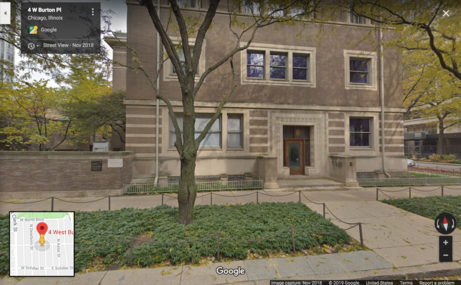
James Hoff’s work often relies on misusing technology as a generative act.
For Lampo and the Graham Foundation, he presents a site-specific version of his most recent audiovisual project HOBO UFO, which uses a custom hack of Google Maps’ Street View to make the platform sound reactive. Hoff’s performance takes place physically and virtually in Chicago, starting at Madlener House and then moving beyond, driven by the real-time music the artist creates from pilfered radio frequencies that transmit GPS and other data streams.
James Hoff (b.1975, Fort Wayne, Ind.) works in a variety of media, including painting, sound, writing, and performance. In recent years, his interests have focused on language and media systems at the intersection of developing technologies and traditional artistic genre forms. He has created paintings and music using computer viruses and developed several bodies of work that examine how the language of network communication has changed our contemporary notions of landscape and nature.
Hoff is also one of the founders of Primary Information, a nonprofit arts organization devoted to publishing artists’ books and art historical documents. He has two releases forthcoming on PAN in 2019, HOBO UFO (Cherynobyl) and an LP of works for French horn and tuba.
James Hoff first performed for Lampo in December 2015.
Since 2010 the Graham Foundation has supported and partnered with Lampo to produce this performance series held at the Madlener House. Lampo, founded in 1997, is a non-profit organization for experimental music and intermedia projects.
Artist Talk: Hoff describes his studio practice as a painter and sound artist, including his reliance on self-distributing and language-based systems, which for him are both metaphors for creation and generative tools. He elaborates on his HOBO UFO project and discusses an “ambient capitalism” and its relationship to the work and the exclusion zone around Chernobyl and Pripyat, Ukraine. Lampo Annex, Monadnock Building, 53 W. Jackson Blvd. #1656. Friday, April 26, 6pm. RSVP for the talk HERE
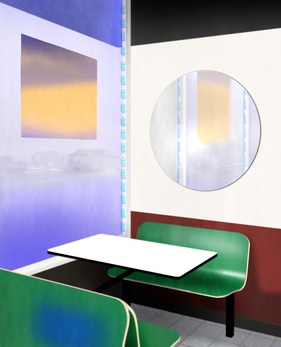
As the Douglas A. Garofalo Fellow from the University of Illinois at Chicago (UIC) School of Architecture, Anne Dessing has researched architectural elements that divide space, such as walls, doors, windows, columns, fences, arches, and gates.
Through a pictorial essay of architectural elements and surfaces from Detroit, St. Louis, and Chicago, Dessing shares her observations as stories of surreal situations in the Midwest. This talk supplements the exhibition of the same name currently on view at the UIC School of Architecture until May 10.
Anne Dessing is an architect based in Amsterdam. Since graduating from the Amsterdam Academy of Architecture in 2012, she has been awarded grants from the Creative Industries Fund NL and the Prince Bernhard Cultural Foundation. Her practice, Studio Anne Dessing, operates at the intersection of art and architecture, and she researches architecture through exhibitions, installations, drawings, models, interiors, and (temporary) buildings. Dessing has taught at the Academy of Architecture in Amsterdam and Rotterdam, the Rietveld Academy, and the Chair of Interiors Buildings Cities at TU Delft.
About the Douglas A. Garofalo Fellowship
Named in honor of architect and educator Doug Garofalo (1958–2011), this nine-month teaching fellowship—supported with a grant from the Graham Foundation—provides emerging designers the opportunity to teach studio and seminar courses in the undergraduate and graduate programs and conduct independent design research. The fellowship also includes a public lecture at the Graham Foundation and an exhibition at the UIC School of Architecture. To learn more about the fellowship, click here.
Image: Anne Dessing, Harold’s Chicken Shack W 87th St, rendering, 2019

Join us for a reception with artist Nelly Agassi to celebrate the opening of her new exhibition Spirit of the Waves.
Through a newly commissioned body of work, including a large-scale textile installation, intricate embroideries, works on paper, sculptures, and a performance, Nelly Agassi conjures historical and imagined narratives from the architectural details of the Graham Foundation’s Madlener House. Built in 1901–02 for Albert F. and Elsa S. Madlener, the house was originally designed by architect Richard E. Schmidt, with designer Hugh M. G. Garden, and then renovated in the 1960s by architect Daniel Brenner to transform it into the Foundation’s headquarters. The culmination of Agassi’s 2019 Graham Foundation Fellowship, this exhibition explores erasure, preservation, identity, and architecture’s capacity to change.
Chicago-based artist Nelly Agassi (b.1973, Israel) received her MFA from Chelsea College and her BFA from Central St. Martins, both in London. Her work has been shown internationally at institutions and galleries such as The Arts Club of Chicago, Aspect Ratio, Hyde Park Art Center, The Israel Museum, Poor Farm, Tate Modern, Tel Aviv Museum of Art, La Triennale di Milano, and Zacheta Warsaw. Agassi is a cofounder of the nonprofit organization Fieldwork Collaborative Projects and a 2019 Graham Foundation Fellow. She is represented by Dvir Gallery and Foksal Gallery.
Agassi worked with Hand and Lock embroidery house in London and The Weaving Mill in Chicago to produce works in the exhibition.
Hand & Lock are London’s premier embroidery house providing embellishment services to the Royal Family, top European design houses, the Royal Armed Forces, Savile Row and members of the public.
The Weaving Mill is an experimental weaving studio in Chicago’s Humboldt Park that blends design, fine art, textile education, and research-based practice.
Spirit of the Waves is commissioned by the Graham Foundation and organized by director Sarah Herda and Ellen Alderman, deputy director of exhibitions and public programs, with James Pike and Ava Barrett. Special thanks to Lori Hanna Boyer and Christopher Rosenberg, Department of Architecture and Design, The Art Institute of Chicago; Jaime Fuentes; Chandra Goldsmith Gray; Scott Heron and Jessica Jane, Hand & Lock; Sharon Hoyer, High Concept Labs; Duncan Jackson and Simon Kristak, Billings Jackson Design; Jennifer Keats, Service Bureau, School of the Art Institute of Chicago; Lauren Mack; Peter Maunu; Ryan Packard; Nathaniel Parks, Ryerson & Burnham Libraries, The Art Institute of Chicago; Emily Frances Winter, The Weaving Mill; and the Graham Foundation staff: Vidisha Aggarwal, Alexandra Drexelius, Carolyn Kelly, Ron Konow, Junxi Lu, and Alexandra Small.
Image: Nelly Agassi, Plot, 2019. Digital manipulation of the 1967 Madlener House plans drawn for the Historic American Buildings Survey. Courtesy of the artist and Graham Foundation, Chicago.
For more information on the exhibition, Spirit of the Waves, click here.
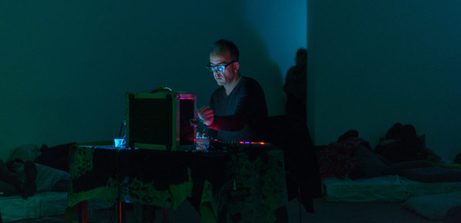
This Ain’t My First Rodeo explores the psychoacoustic interactions between two synthesizers in quad sound, with additional material generated and mutated by 1/4-inch tape delay. Anthony Pateras’ new project wraps listeners in an extraordinary sensory experience of musical illusions.
The title itself also may be deceptive. Pateras is no novice, after more than 20 years on the scene. But don’t read the work as any kind of boast. Instead, the rodeo reference is akin to the turbulent self-reinvention he went through when starting this piece, which he reveals last happened when he wrote "Blood Stretched Out" for Lampo in 2014.
Pateras finds inspiration in the words of poet Adrienne Rich: “All new learning looks at first like chaos.”
“Music is so mysterious. When you find something that works, you can be very tempted to keep doing the same thing,” says the Australian composer.
“I tend to get bored and look for a new take or approach. It feels very chaotic, but I remind myself that’s what you always have to go through. This seems to be the ideal state for a musician to do a good job—terrified curiosity.”
Anthony Pateras is a composer and performer whose current work focuses on electroacoustic orchestration, temporal hallucination and sound phenomena. Pateras has created over 75 works, receiving performances from the Los Angeles Philharmonic, Australian Chamber Orchestra and BBC Symphony; commissions from the GRM, Slagwerk Den Haag and Südwestrundfunk Baden-Baden; residencies from ZKM, Akademie Schloss Solitude and La Becque; and fellowships from Creative Victoria, and the Ian Potter and Sydney Myer Foundations. He has released over 40 albums including collaborations with Mike Patton, Stephen O’Malley and Valerio Tricoli. Aside from solo concerts, he currently performs with eRikm, Jérôme Noetinger and Erkki Veltheim.
Pateras made his Chicago debut for Lampo and the Graham Foundation in May 2011.
Since 2010 the Graham Foundation has supported and partnered with Lampo to produce this performance series held at the Madlener House. Lampo, founded in 1997, is a non-profit organization for experimental music and intermedia projects.
Image: Courtesy of the artist.
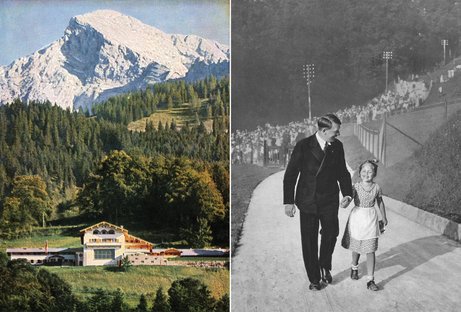
Hitler at Home examines the aesthetic and ideological construction of Hitler's domesticity, focusing on his two private residences in Bavaria: the Berghof on the Obersalzberg and his Munich apartment at Prinzregentenplatz 16. Through the architectural and media creation of these places, the Nazi regime fostered the myth of the private Hitler as peaceable homebody and good neighbor, an image used strategically and effectively within Germany and abroad to distance the Führer from Europe's violence. Moreover, this image helped to dispel any suspicions raised by the Führer’s bachelor status that may have threatened the Nazi cult of domesticity. Largely ignored by historians as politically or architecturally insignificant, the fabrication of Hitler's private spaces reveals how the occupant imagined his interiority, how he positioned this self in relation to his public identity, and how intricately and expertly artists and propagandists of the regime interwove these facets into a seductive whole.
Despina Stratigakos is SUNY Buffalo’s vice provost for inclusive excellence and professor of architecture in the Department of Architecture. She is the author of three books that explore the intersections of power and architecture, including Where Are the Women Architects? (Princeton University Press, 2016), and Hitler at Home (Yale University Press, 2015). She is currently writing a book on the Nazis’ building plans for occupied Norway (forthcoming 2020). Stratigakos is a Graham Foundation grantee has served as a director of the Society of Architectural Historians, an advisor of the International Archive of Women in Architecture at Virginia Tech, and a trustee of the Beverly Willis Architecture Foundation in New York.
Related Graham supported projects:
2015 grant to Despina Stratigakos for the publication Hitler at Home
2010 grant to Despina Stratigakos for research on the publication Hitler at Home
Image: Left: Heinrich Hoffmann, postcard of the Berghof, Hitler’s mountain home on the Obersalzburg, ca. 1936. Right: Heinrich Hoffmann, photograph of Hitler escorting a girl to his Obersalzburg house, from Hoffmann’s Youth around Hitler (1934).
For more information on the exhibition, Spirit of the Waves, click here.
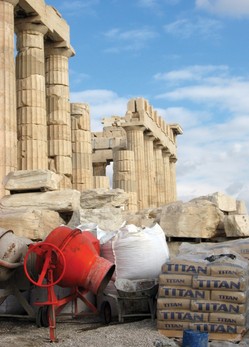
The marble workers laboring on the decades‐long restoration of the Acropolis are inheritors of a millennia-old tradition. Their work is a highly technical amalgam of past and present, yet what these master marble carvers do and how they do it has been undocumented until now. As the restoration enters its final phases, On the Rock: The Acropolis Interviews reveals the marble workers’ techniques, training, and roles within the restoration in the their own frank, deeply personal voices, as interviewed by Graham grantee Allyson Vieira. The interviews address ancient building practices, the teaching of traditional craft, changes in the practice of architectural restoration, and social and class dynamics within the restoration site, while considering Greece’s economic crisis from the workers’ perspective. How has the Greek crisis affected the technicians’ thoughts about their craft, jobs, and citizenship? Vieira will explore the intersection of these issues in conversation with Terri Kapsalis, author of a recently completed novel set in Athens.
Artist Allyson Vieira lives and works in New York. She has exhibited extensively both internationally and in the US, including institutional projects at Kunsthalle Basel (Basel), Swiss Institute (NY), Storm King Art Center (NY), PinchukArtCentre (Kiev), Non-Objectif Sud (Tulette), Frieze Projects (NY), The Public Art Fund (NY), The Highline (NY), and SculptureCenter (NY), and recent solo gallery exhibitions at Daniel Faria (Toronto), Company (NY), Klaus von Nichtssagend (NY), Mendes Wood DM (Sao Paulo, BR), The Breeder (Athens), and Laurel Gitlen (NY). Her first major catalog, Allyson Vieira: The Plural Present, was published by Karma Books in 2016. She is currently assistant professor of foundations at the Corcoran School of Art at the George Washington University in Washington, DC.
Terri Kapsalis is a writer and performer. She is the author of Jane Addams' Travel Medicine Kit, The Hysterical Alphabet, and Public Privates: Performing Gynecology from Both Ends of the Speculum. Her writings have appeared on Lit Hub and in various edited volumes and journals including Short Fiction, The Baffler, Denver Quarterly, New Formations, Public, and Parakeet. Along with John Corbett and Anthony Elms, she coedited Traveling the Spaceways: Sun Ra, the Astro Black, and Other Solar Myths and Pathways to Unknown Worlds: Sun Ra, El Saturn, and Chicago’s Afro-futurist Underground and cocurated the touring Sun Ra exhibition Pathways to Unknown Worlds. As an improvising violinist, Kapsalis' discography includes work with Tony Conrad, David Grubbs, Mats Gustafsson, Junko, and Thurston Moore. She is a founding member of Theater Oobleck and has performed in over thirty productions since 1985. Since 1991, she is a collective member and health educator at the Chicago Women's Health Center and cofounded TGAP (Trans Greater Access Project) and the Integrative Health Program. She teaches at the School of the Art Institute of Chicago.
Soberscove Press seeks to make available art-related materials that fill a gap in the literature or are difficult to access. Our books tend to explore modes and functions of documentation and connect historical themes and issues to the present. Soberscove also works with artists on the production of books that resonate with our list.
Image: Work on the Parthenon continues as part of the decades‐long Acropolis restoration project. Photo: Allyson Vieira
For more information on the exhibition, Spirit of the Waves, click here.
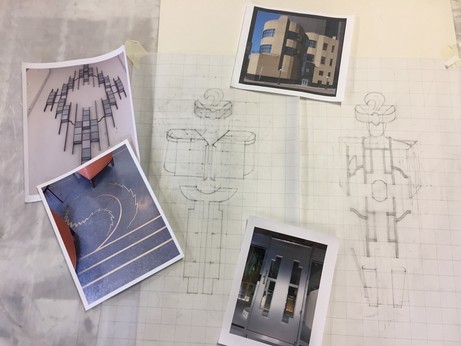
In 2018, Diane Simpson received a research grant from the Graham Foundation to support her project Architecture in Motion commissioned by FD13 Residency for the Arts in Minneapolis-Saint Paul, MN. Working over an extended research period of nine months, Diane designed her first costumes to be animated by two performers. Taking inspiration from the former Women’s City Club of St. Paul, designed by architect Magnus Jemne in 1931 in the Art Deco style, Simpson’s costumes reference key details of the elegant building. In collaboration with FD13, the costumes were first used in performance with Minneapolis-based dancers in June 2019. Building on the success of this first iteration, Every house has a door created a new performance to premiere on July 25. Following the 30-minute performance, Sara Cluggish, Director of FD13 joins Diane Simpson in conversation about the evolution of the project.
Diane Simpson is a Chicago-based artist who creates sculpture and preparatory drawings that evolve from a diverse range of sources, including clothing, utilitarian objects, and architecture. The structures of clothing forms has continuously informed her work, serving as a vehicle for exploring their functional and sociological roles and the influence of the design and architecture of various cultures and periods in history. Diane Simpson’s works were included in the 2019 Whitney Biennial. Other museum exhibitions include solo shows at the Museum of Contemporary Art Chicago (2016) and the Institute of Contemporary Art/Boston (2015). Recent solo gallery exhibitions include Herald St, London (2018); JTT, New York (2016); and Corbett vs. Dempsey, Chicago (2016).
Sara Cluggish is a writer and curator based in Minneapolis. She earned her MFA in curating and BFA in photography. Her research interests lie at the intersection of performance and moving image scholarship, with an emphasis on gender and sexuality studies. Cluggish is 2018 Guest Curator of FD13, Residency for the Arts in Minneapolis and St. Paul for which she is developing a season of events surrounding themes of health, illness, disability politics, and the body in a state of flux. From 2012 to 2014 she was the assistant curator at Nottingham Contemporary and has worked in the exhibitions departments at Chisenhale Gallery, London; Whitechapel Gallery, London; and the Contemporary Arts Center in Cincinnati, Ohio. She is an occasional contributor to ArtReview, ArtReview Asia, Frieze, L’Officiele Arte Italia, and the Third Rail.
Every house has a door was formed in 2008 by Lin Hixson, director, and Matthew Goulish, dramaturg, to convene diverse, inter-generational project-specific teams of specialists, including emerging as well as internationally recognized artists. Drawn to historically or critically neglected subjects, Every house creates performance works and performance-related projects in many media. The company is based in Chicago and presents work for local, national, and international audiences.
Image: Diane Simpson, source images from the former St. Paul Women’s City Club, designed by Magnus Jemne in 1931, with Architecture in Motion costume drawings, 2019
For more information on the exhibition, Spirit of the Waves, click here.
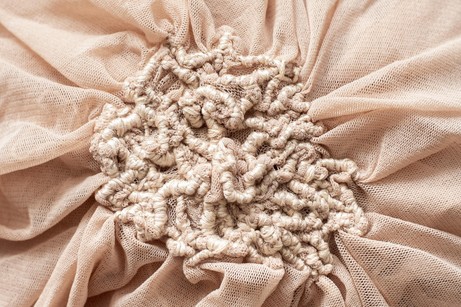
Wednesday, July 31, 6 p.m.
Sold out (Join the waitlist)
Wednesday, August 7, 6 p.m.
Sold out (Join the waitlist)
Nelly Agassi presents a new performance within her site-specific installation as part of her Graham Foundation fellowship exhibition, Spirit of the Waves. Developed in collaboration with Ryan Packard and Peter Maunu, the performance title refers to a line of poetry that was inscribed on a bracelet from Elsa Seipp Madlener—who, along with her husband Albert Fridolin Madlener, commissioned the house the Foundation inhabits—that has been passed down through the Seipp-Madlener family for multiple generations. The quoted passage is taken from the stanza “Vom Tode” (“From Death”), part of Christian Fürchtegott Gellert’s 1757 work Geistliche Oden und Lieder (Spiritual Odes and Songs), which was later adapted to music and popularized by both Bach and Beethoven, in 1758 and 1803 respectively.
Chicago-based artist Nelly Agassi (b.1973, Israel) received her MFA from Chelsea College and her BFA from Central St. Martins, both in London. Her work has been shown internationally at institutions and galleries such as The Arts Club of Chicago, Aspect Ratio, Hyde Park Art Center, The Israel Museum, Poor Farm, Tate Modern, Tel Aviv Museum of Art, La Triennale di Milano, and Zacheta Warsaw. Agassi is a cofounder of the nonprofit organization Fieldwork Collaborative Projects and a 2019 Graham Foundation Fellow. She is represented by Dvir Gallery and Foksal Gallery.
Guitarist and violinist Peter Maunu has toured, performed, and recorded with a long list of diverse musicians including Charles Lloyd, Jean-Luc Ponty, Bobby McFerrin, Tony Williams, Billy Cobham, Charlie Haden, Archie Shepp, and Grace Slick. As the guitarist on the Arsenio Hall Show, he performed nightly with legends like Wayne Shorter, Chick Corea, Herbie Hancock, Ringo Starr, Madonna, Ray Charles, NWA, Public Enemy, and many more. Additionally, Maunu contributed to the soundtracks of film scores including Crash, Bobby, Food Inc., and television shows Chicago Hope, Arrested Development, and CSI New York. Since relocating to Chicago, he has performed and recorded with improvisers Fred Lonberg-Holm, Dave Rempis, Michael Zerang, Mars Williams, Jim Baker, Tomeka Reid, Katherine Young, Jason Roebke, Tim Daisy, Ryan Packard, Nelly Agassi, Avreeyal Ra, dancer Ayako Kato, and many others. In addition, he founded, curates, hosts, and performs at the Splice Series, a bimonthly improvisation series at the Beat Kitchen in Chicago.
Ryan Packard is a percussionist, composer, and sound artist based in Chicago. His sound installations have been featured at the Museum of Contemporary Art Chicago, Defibrillator Gallery, Hyde Park Arts Center, Galeria Labirynt, High Concept Labs, Constellation Chicago, and Experimental Sound Studio. His compositions have been performed by Fonema Consort, Ensemble Chartreuse, Seth Parker Woods, The Morton Feldman Chamber Players, and the AndPlay Duo. As an improviser and collaborator, Packard performs regularly with Nelly Agassi, Dave Rempis, Brandon Lopez, Jasper Stadhouders, Oscar Jan Hoogland, ZRL (Zach Good and Lia Kohl), John McCowen, Nestle (Cyrus Pireh and Rob Lundberg), ombra di organo (Keefe Jackson and Manuel Troller), Kieran Daly, Jason Roebke, RGB (Paul Giallorenzo and Charlie Kirchen), Daniel Wyche amongst many others. He is in the newest reincarnation of the NYC experimental indie rock band, Skeleton$; Chicago’s Wei Zhongle; and collaborates with the Michael Albert Music Group, Slow Mass and VV Lightbody. He’s a member of Fonema Consort and has performed with Ensemble Dal Niente, Joshua Abrams & Natural Information Society, MOCREP, a.pe.ri.od.ic ensemble, Chicago Composer’s Orchestra, Nate Kinsella’s Birthmark and Architek Percussion Quartet as a founding member. Packard has a master's of music from McGill University and bachelor's of music from the Oberlin Conservatory of Music.
Image: Nelly Agassi, Untitled, 2019. Photo: Assaf Evron
Please note that registration for this performance is required, but does not guarantee entry. Doors open 30 minutes prior to the event and space is available on a first-come, first-serve basis for those registered in advance. Reservations expire 5 minutes before the event start time, at which point space will be released to the waitlist. No late entry will be permitted.
Accessibility: This event will be held on the second floor, which is only accessible by stairs, and will not be seated. A limited number of stools for those unable to stand for the duration of the 30 minute performance will be available. The first-floor galleries, library, and bookshop are accessible via outdoor lift. Please call ahead to make arrangements.
For more information on the exhibition, Spirit of the Waves, click here.
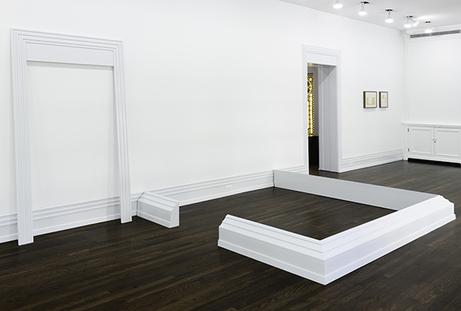
Artist-led tours of Spirit of the Waves (approx. 45 min.):
Friday, August 9, 12 p.m.
Wednesday, August 14, 12 p.m.
Friday, August 16, 12 p.m.
Our current exhibition, Nelly Agassi: Spirit of the Waves, has been extended with special hours through August 16th. Join artist Nelly Agassi for a tour of her Graham Foundation Fellowship exhibition that explores erasure, preservation, identity, and architecture’s capacity to change. This newly commissioned body of work, includes a large-scale textile installation, intricate embroideries, works on paper, and sculptures that conjure historical and imagined narratives from the architectural details of the Foundation's headquarters, the Madlener House. Agassi will discuss her work and practice during her residency.
Advanced registration for the tours is not required; additional tours are available by appointment.
For more information on the exhibition, Spirit of the Waves, click here.
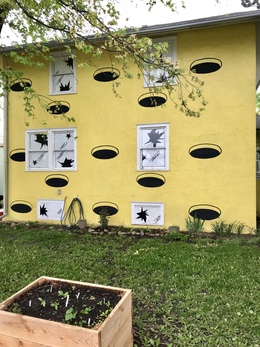
FAMILY PROGRAM
Using pavement, chalk, bouncy balls, and bean bags, artist Alberto Aguilar transforms the sidewalks surrounding the Madlener House into a floor game court and participatory performance. This event is designed as an outdoor program for children and families though participants of every age are invited to join.
This event is presented in collaboration with Cultural ReProducers in conjunction with the exhibition Estudio Tatiana Bilbao: Unravelling Modern Living.
Alberto Aguilar is a Chicago based artist. He has exhibited at the Museum of Contemporary Art Detroit; El Centro de Desarrollo de las Artes Visuales, Havana, Cuba; Palo Alto Art Center; National Museum of Mexican Art, Chicago, IL; Museum of Contemporary Art Chicago; Minneapolis Institute of Art: Crystal Bridges Museum of American Art, Bentonville, AR; and The Art Institute of Chicago. His work is held in the collections of the National Museum of Mexican Art; Crystal Bridges Museum of American Art; Soho House Chicago; and the Chicago Cultural Center. Aguilar is the recipient of the 3Arts Award.
Cultural ReProducers is an evolving group of active cultural workers—artists, designers, curators, musicians, performers, writers, etc.—who are also parents. Founded in 2012 by artist Christa Donner, the group is a creative platform, web resource, and community-based initiative that is for anyone interested in making the art world a more inclusive and interesting place by supporting arts professionals raising kids.
Image: Multiple Entires, latex paint and window signs on home, 2018.
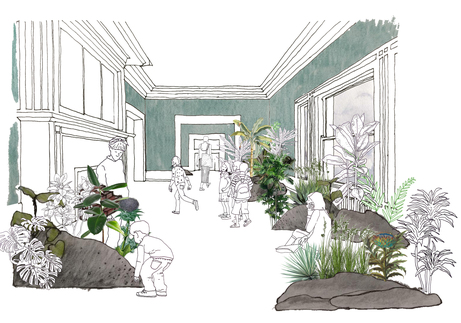
Tatiana Bilbao Estudio, from Unraveling Modern Living, digital collage, 2019
Join us for a reception with Tatiana Bilbao Estudio to celebrate the opening of the new exhibition Unraveling Modern Living.
Mexico City-based architecture office Tatiana Bilbao Estudio creates an immersive installation that transforms a former domestic space to explore new forms of collectivity. The installation is activated by collaborative projects, on-site talks, and workshops throughout the run of the exhibition with Archeworks, Colectivo 1050º, Cultural ReProducers, Fieldwork Collaborative Projects, Stefan Gruber, Nance Klehm of Social Ecologies, Lurie Garden, MAS Context, Midewin National Tallgrass Prairie, Sweet Water Foundation, The Weaving Mill, and Anna Martine Whitehead, among others.
Tatiana Bilbao founded her Mexico City-based eponymous architecture studio in 2004. Her work analyzes site specificity and creates built environments through multidisciplinary and cross-cultural perspectives. She has taught as a visiting professor at the Yale School of Architecture, Harvard Graduate School of Design and Columbia University Graduate School of Architecture, Planning and Preservation. Bilbao’s work has been published in Architecture + Urbanism, GA Houses, Domus, and The New York Times, among other outlets.
Tatiana Bilbao Estudio creates work internationally at various scales, translating vernacular social codes into architecture, to develop affordable and sustainable architectural practices. Highlighted projects in Mexico include: the Culiacán Botanical Garden; the Pilgrim Route, Jalisco; and the Biotechnological Center, Sinaloa. In 2015 the studio built the Sustainable House, a social housing prototype displayed at the Chicago Architectural Biennial. The work has been recognized widely with awards such as the Berlin Art Prize and the Global Award for Sustainable Architecture.
This exhibition is presented in partnership with the 2019 Chicago Architecture Biennial.
Image: Tatiana Bilbao Estudio, from Unraveling Modern Living, digital collage, 2019
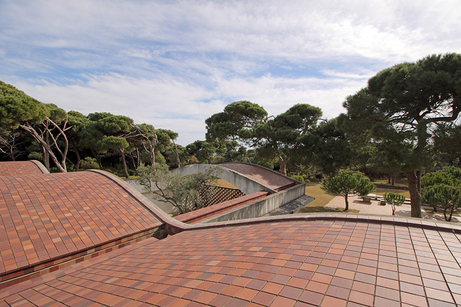
La Ricarda or Casa Gomis, completed in 1963, is one of the key midcentury buildings in Spain. Barcelona-born architect Antonio Bonet Castellana, who trained with Le Corbusier and Josep Lluís Sert, designed the house while living in Buenos Aires. Working closely with the clients, Ricardo Gomis and Inés Bertrand via letters, Bonet designed every aspect of the building, from the overall organization to the materials, interior details, and furniture. Besides its architectural merit, the house is also remarkable for the critical cultural role it has played in Catalonia, particularly during Franco’s dictatorship, when the Gomis Bertrand family supported and welcomed artists and intellectuals such as John Cage, Merce Cunningham, Josep Mestres Quadreny, Carles Santos, Joan Prats, Robert Gerhard, Villèlia, Antoni Tàpies, Joan Miró and Joan Brossa, transforming it into a haven for artistic experimentation.
Having grown up in Casa Gomis, Marita Gomis discusses the design and construction of the iconic house, the cultural activities it hosted, its relevance more than five decades after it was built, and the efforts and challenges to preserve it.
This talk accompanies the exhibition La Ricarda: An Architectural and Cultural Project organized by MAS Context, on view October 12, October 19, and October 26, 2019 at Lawrence & Clark.
This event is a partner program of the 2019 Chicago Architecture Biennial.
Marita Gomis, along with her five siblings, is the owner of Casa Gomis, one of the key midcentury buildings in Spain and the house she grew up in. Commissioned by Ricardo Gomis and Inés Bertrand, it was designed by Antonio Bonet Castellana and completed in 1963. A haven for artistic experimentation, the house hosted many cultural activities and continues to be a must-see destination for architecture students and professionals from around the world. Marita and the rest of the Gomis Bertrand family has diligently preserved it in its original state with the help of local architects Fernando Álvarez and Jordi Roig.
MAS Context is nonprofit a quarterly journal created by MAS Studio in Chicago that addresses concerns that affect the urban context. Each issue delivers a comprehensive view of a single topic through the active participation of people from different fields and perspectives who, together, instigate the debate.
Lawrence & Clark is a collection-based gallery run by Jason Pickleman. The collection spans more than 1000 works in all media. The storefront gallery is an opportunity to exhibit privately held artwork in a public setting. The gallery is open every Saturday from 1 p.m. until 5 p.m. and by appointment. For more information, please visit: lawrenceandclark.com.
Image: Casa Gomis, El Prat de Llobregat, 2019. © Iker Gil.
For more information on the exhibition, Tatiana Bilbao Estudio: Unraveling Modern Living, click here.
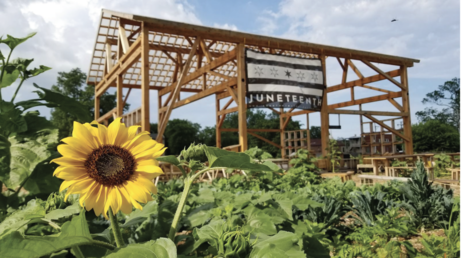
Hosted by Sweet Water Foundation at The Commons, 5749 S Perry Avenue, Chicago IL
Sweet Water Foundation is excited to welcome participants at its flagship site, The Commons, for a two-hour tour and hands-on experience on Wednesday, October 23. During the workshop, participants will be challenged to explore their relationship with the world around them, integrate Sweet Water Foundation’s practice of Regenerative Neighborhood Development in their lives, and consider the relationship between places where one lives, where things grow, and where things are built or torn down. Participants will engage in hands-on activities such as farming/gardening techniques, carpentry, and printmaking.
Sweet Water Foundation practices regenerative neighborhood development, a creative social justice method, that creates safe and inspiring spaces by establishing healthy, intergenerational communities that transform the ecology of once-“blighted” neighborhoods. The Foundation utilizes a blend of urban agriculture, art, and education to transform vacant spaces and abandoned buildings into economically and ecologically productive and sustainable community assets that produce engaged youth, skilled workers, art, locally-grown food, and affordable housing. These principles are realized in the flagship Foundation project, the Perry Avenue Commons, encompassing approximately three acres on the South Side of Chicago.
Image: The Thought Barn at The Commons, Sweet Water Foundation
For more information on the exhibition, Tatiana Bilbao Estudio: Unraveling Modern Living, click here.
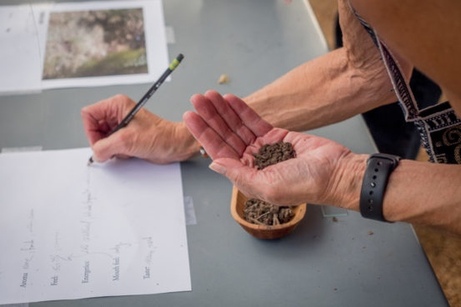
The practice of eating earth or soil-like substrates such as clay or chalk has a deep anthropological history and is practiced by various cultures around the world. For this program Klehm has collected soil from various locations around Chicago and her team will guide participants through a tasting to sensorially explore the minerals and biological processes that cause the different ‘notes’ and flavors of soil.
As part of the ongoing exhibition, Klehm and her collaborator and colleague Jacob Blecher will present their Deep Maps of two earthen sites in Chicago: Madlener House (Gold Coast) and Raber House (Englewood) will be presented along with soil corings on trays made from local clay Klehm has dug and processed.
Nance Klehm is internationally respected for her work on land politics and soil health. Her work has received extensive national and international media coverage amongst those: Time Magazine, BBC Canada, MSN, Los Angeles Times, Philadelphia Inquirer and is mentioned in many books, including Leila Darwish’s Earth Repair (2013), Sandor Katz’s The Revolution Will Not Be Microwaved (2006) and Alexandra Toland's Field to Palette: Dialogues on Soil and Art in the Anthropocene (2019). She won the 2010 Utne Visionary Prize and is a member of the Curry-Stone Design Prize Social Design Circle. In addition, she has lectured broadly in museum and university settings as well as for countless community groups worldwide. Klehm is the author of: The Ground Rules: a manual to reconnect soil and soul (2016) and The Soil Keepers: Interviews with practitioners on the ground beneath our feet (2019) and is working on a manual on microbial remediation of contaminated soils. Most recently, she was the subject of the independent documentary, Weedeater. Nance splits her time between La Villita, a densely packed, urban neighborhood in Chicago and her 50 acres of land in The Driftless Region. http://www.socialecologies.net
Jacob Blecher is a writer, grower, and horticulturalist based in Wilmington, NC. With Social Ecologies, he helped develop a city-wide community composting and bioremediation project in Chicago called The Ground Rules. He holds a BA from Yale University and an MA in Political Science from the University of Chicago.
Image: Nance Klehm, documentation from Hyperobjects – Mineral
Free Exposure Soil Tasting with artist and ecologist Nance Klehm at Capri in Marfa, Texas, August 24, 2018. Courtesy Ballroom Marfa. Photo: Rowdy Lee Dugan
For more information on the exhibition, Tatiana Bilbao Estudio: Unraveling Modern Living, click here.
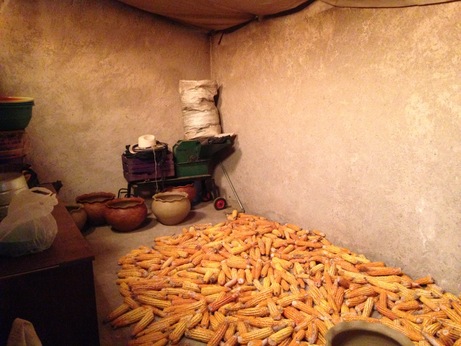
María Bautista teaches the traditional way of making pottery in Chiapas, which she learned when she was eight years old. The instruction begins with sharing how clay is harvested in the fields through to firing clay works in a wood kiln. Bautista instructs how to hand-build clay using essential tools to create vessels used to eat and drink. This program also includes creating and enjoying a traditional maize-based drink.
Innovando la Tradición is a collective and multidisciplinary nonprofit that seeks to revitalize traditional pottery in Oaxaca, Mexico to bring visibility to the profound knowledge of this centuries-old craft. The organization positions pottery as a tool of economic stability, cultural development, an agent of social cohesion, and a source of inspiration in the construction of new paradigms for a more balanced relationship with the world. This mission is realized through workshops, courses, and skill exchanges to share the work of master potters and pass on the discipline to younger artisans. Colectivo 1050º is the commercial arm of the nonprofit Innovando la Tradición, and sells the products that are handmade in Oaxaca by traditional potters and designers. The company operates on principles of fair trade, with a strong emphasis on ecologically sound practices.
María Bautista León was born into a Mexican family dedicated to pottery and she considers herself as potter since the age of eight. She has shared this ancestral wisdom with other people who have an interest in learning how to mold and create with their hands through this noble activity. Additionally, León has collaborated on the project Mujeres y Maíz (Women and Maize), which builds paths for food sovereignty and good living alongside women who sell corn products like toasts, tortillas, and tamales.
Kythzia Barrera is an industrial designer, and cofounder of Innovando la Tradición and Colectivo 1050º, organizations that support the development of pottery communities in Oaxaca, Mexico. Barrera’s work strengthens the bridges between art, craft, and design to foster social and human change. Honesty and open disclosure from the conventional and privileged designers position shapes an essential part of Kythzia's creative leadership as Head of Innovando Tradición and dynamic CEO of Colectivo 1050º. She holds a master’s degree in social and sustainable design by The Design Academie Eindhoven, Netherlands; in addition to having completed postgraduate coursework in ceramics at the School of Art and Design Helsinki, Finland; and in crafts and design at Kyoto Institute of Technology. She previously served as sustainable design professor at Centro and Universidad Iberoamericana, Mexico.
Diego Mier y Terán is cofounder and director of Innovando la Tradición and Colectivo 1050º and is interested in the social and ethical dimension of design and its power as an agent of change. He holds a master’s degree in type design from Royal Academy of Art, The Hague, Netherlands. Terán teaches across many universities in Mexico and previously ran the Workshop of Utopias at the Universidad Iberoamericana which prepared students to challenge the conventions of contemporary society and design practice.
Image: Innovando la Tradicion archive
For more information on the exhibition, Tatiana Bilbao Estudio: Unraveling Modern Living, click here.
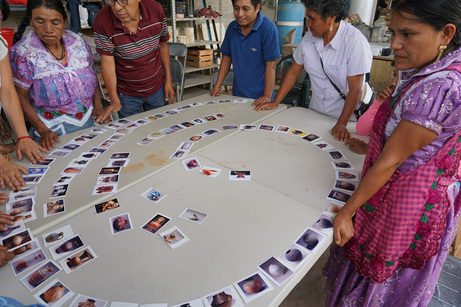
Kythzia Barrera Suárez and Diego Mier y Terán, directors of Innovando la Tradicion, have dedicated their lives to unlearn contemporary design practice and the paradigms of modern society through the work of indigenous and rural potters of Oaxaca, Mexico. Together with María Bautista they discuss the Learning Community of Potters, a space for exchanging knowledge from a centuries-old craft that is rooted in a culture of balance, community, and close attention to nature.
Innovando la Tradición is a collective and multidisciplinary nonprofit that seeks to revitalize traditional pottery in Oaxaca, Mexico to bring visibility to the profound knowledge of this centuries-old craft. The organization positions pottery as a tool of economic stability, cultural development, an agent of social cohesion, and a source of inspiration in the construction of new paradigms for a more balanced relationship with the world. This mission is realized through workshops, courses, and skill exchanges to share the work of master potters and pass on the discipline to younger artisans. Colectivo 1050º is the commercial arm of the nonprofit Innovando la Tradición, and sells the products that are handmade in Oaxaca by traditional potters and designers. The company operates on principles of fair trade, with a strong emphasis on ecologically sound practices.
María Bautista León was born into a Mexican family dedicated to pottery and she considers herself as potter since the age of eight. She has shared this ancestral wisdom with other people who have an interest in learning how to mold and create with their hands through this noble activity. Additionally, León has collaborated on the project Mujeres y Maíz (Women and Maize), which builds paths for food sovereignty and good living alongside women who sell corn products like toasts, tortillas, and tamales.
Kythzia Barrera is an industrial designer, and cofounder of Innovando la Tradición and Colectivo 1050º, organizations that support the development of pottery communities in Oaxaca, Mexico. Barrera’s work strengthens the bridges between art, craft, and design to foster social and human change. Honesty and open disclosure from the conventional and privileged designers position shapes an essential part of Kythzia's creative leadership as Head of Innovando Tradición and dynamic CEO of Colectivo 1050º. She holds a master’s degree in social and sustainable design by The Design Academie Eindhoven, Netherlands; in addition to having completed postgraduate coursework in ceramics at the School of Art and Design Helsinki, Finland; and in crafts and design at Kyoto Institute of Technology. She previously served as sustainable design professor at Centro and Universidad Iberoamericana, Mexico.
Diego Mier y Terán is cofounder and director of Innovando la Tradición and Colectivo 1050º and is interested in the social and ethical dimension of design and its power as an agent of change. He holds a master’s degree in type design from Royal Academy of Art, The Hague, Netherlands. Terán teaches across many universities in Mexico and previously ran the Workshop of Utopias at the Universidad Iberoamericana which prepared students to challenge the conventions of contemporary society and design practice.
Image: Innovando la Tradicion archive
For more information on the exhibition, Tatiana Bilbao Estudio: Unraveling Modern Living, click here.
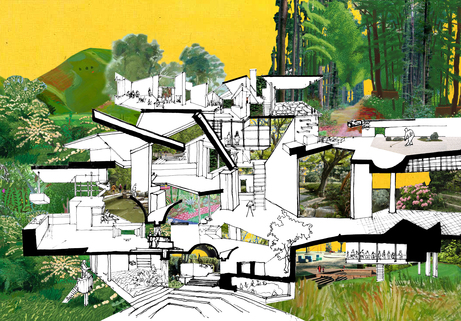
This event will be hosted at Rubloff Auditorium | 230 S Columbus Drive, Chicago, IL 60603
Tatiana Bilbao is an award-winning, Mexico City-based architect whose global practice is grounded in a commitment to sustainability, community, and context in design. Born into a family of architects, Bilbao founded her multidisciplinary office in 2004 with a single fundamental ideal: “architecture should benefit every single human being on this planet.” This goal has taken many different forms, from engagements with public space, including her work at the Botanical Garden of Culiacán, Mexico, to research on social housing with projects like the Sustainable House, a low-cost housing prototype exhibited at the 2015 Chicago Architecture Biennial. A passionate teacher and lecturer, Bilbao is part of an international vanguard of architectural practice and education whose roots remain inextricably tied to the culture and history of Mexico City.
Tatiana Bilbao founded her Mexico City-based eponymous architecture studio in 2004. Her work analyzes site specificity and creates built environments through multidisciplinary and cross-cultural perspectives. She has taught as a visiting professor at the Yale School of Architecture, Harvard Graduate School of Design and Columbia University Graduate School of Architecture, Planning and Preservation. Bilbao’s work has been published in Architecture + Urbanism, Domus, and The New York Times, among other outlets.
Tatiana Bilbao Estudio creates work internationally at various scales, translating vernacular social codes into architecture, to develop affordable and sustainable architectural practices. Highlighted projects in Mexico include: the Culiacán Botanical Garden; the Pilgrim Route, Jalisco; and the Biotechnological Center, Sinaloa. In 2015 the studio built the Sustainable House, a social housing prototype displayed at the Chicago Architectural Biennial. The work has been recognized widely with awards such as the Berlin Art Prize and the Global Award for Sustainable Architecture.
For more information on the exhibition, Tatiana Bilbao Estudio: Unraveling Modern Living, click here.
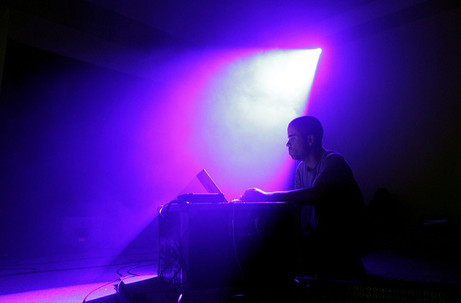
You could say that pretty much anything Roc does is a direct homage to the history of house music, but this new audiovisual piece for Lampo and the Graham Foundation is an explicit tribute to the legacy of early Chicago house. Wonky bass lines and drum patterns get continuously bent, flexed and contracted in unexpected ways.
Six Hexaflexagons for Chicago is his weird love letter to the tracks, producers and sounds that shaped dance music, turned into a stream of awkward locked grooves and algorithmically-churned acid motifs.
Roc Jiménez de Cisneros (b.1975, Barcelona) is part of the computer music group EVOL together with Scottish artist Stephen Sharp. Their work considers processes of deformation applied to post-acid house culture. Their recordings have been published by record labels such as Diagonal, Editions Mego, Presto!?, iDEAL, Hypermedium and others. Much of Roc’s work is rooted in an interpretation of music in morphological terms: mutated forms, spatial relationships and elasticity, both in a metaphorical sense and a literal one. Since 2013 he has been pushing this spatial-material approach to music in different ways, originally drawing connections between holes and music, then extending that to folds and folding, to produce a series of pieces, talks, light installations and publications that propose a reevaluation of musical phenomena as volumetric and topological structures.
Roc Jiménez de Cisneros has presented his work twice before in the Lampo series. Performing as EVOL in February 2016, he premiered Opus17aSlimeVariation#8—a reinterpretation of Hanne Darboven’s Opus 17a. In October 2011, he played a new four-channel work for computer and hand-held air horns, titled Tetralemma + Tetrafluoroethane.
Since 2010 the Graham Foundation has supported and partnered with Lampo to produce this performance series held at the Madlener House. Lampo, founded in 1997, is a non-profit organization for experimental music and intermedia projects.
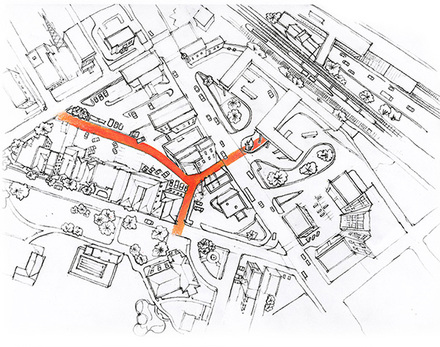
Building upon 25 years of teaching the power of design to tackle social, cultural, and environmental challenges in Chicago, Archeworks—a free alternative school founded by Stanley Tigerman and Eva Maddox—hosts a conversation with local practitioners to define new opportunities around the idea of collectivity in the city. Join local practitioners for a discussion addressing topics close to the institution’s mission such as universal design and accessibility to community health, local food systems, and sustainable land use.
Archeworks mission is to use the power of design to challenge social, cultural and environmental challenges in Chicago. Founded in 1994 by architect Stanley Tigerman and designer Eva Maddox, Archeworks has collaborated with over 80 partners and completed more than 80 design projects in communities throughout Chicago. Past partners include community organizations, urban farms, advocacy groups, healthcare organizations, schools, municipalities, and cultural institutions. These collaborative design projects have addressed subjects ranging from universal design and accessibility to community health, local food systems, and sustainable land use.
Image: Thomas Chiu, Good City Group, The Last Mile, 2015, Chicago. Courtesy of Archeworks.
For more information on the exhibition, Tatiana Bilbao Estudio: Unraveling Modern Living, click here.
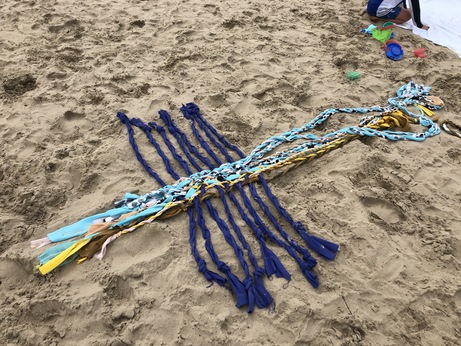
Twisting recycled fabrics into giant yarns, we will create a macro-weaving, using our bodies to create a multi-person-human-loom, transforming weaving into a participatory game that zooms in on the over-under of woven cloth. This workshop is recommended for children 5 and older.
The Weaving Mill is an experimental weaving studio in Chicago’s Humboldt Park that blends design, fine art, textile education, and research-based practice.
For more information on the exhibition, Tatiana Bilbao Estudio: Unraveling Modern Living, click here.

Author and Midewin volunteer Arthur Pearson and Midewin Archaeologist, Tribal Liaison and Heritage Program Manager Joe Wheeler will share the history of Midewin and lead a conversation about prairie connections in the built and natural environments.
United States Department of Agriculture (USDA) Forest Service International Programs & USDA Forest Service—Midewin National Tallgrass Prairie is the first of its kind in the country. Midewin represents a major effort to restore 20,000 acres of farm and industrial land to a unique American landscape and the complex ecology of the prairie. It is the largest open space in the Chicago metropolitan area and northeastern Illinois and the largest tallgrass prairie restoration effort east of the Mississippi River.
Arthur Melville Pearson is the former Director, Chicago Program for the Gaylord and Dorothy Donnelley Foundation, where he guided investments in land conservation, the arts and collections. He is the author of Force of Nature (University of Wisconsin Press, 2017) an award-winning biography of George Fell, founder of The Nature Conservancy and the Illinois Nature Preserves Commission. A long-time volunteer at Midewin, Arthur is currently writing a book-length history of Midewin, entitled, A Midewin Almanac.
Joseph Wheeler is the Prairie Archaeologist, Heritage Program Manager and Tribal Liaison at the USDA Forest Service - Midewin National Tallgrass Prairie. Before coming to Midewin in 2013 he was a field archaeologist based out of the Forest Service’s Rocky Mountain region, working throughout the West and Southwest United States. He attended graduate school in Anthropology, specializing in Archaeology, at the University of Wyoming and holds a BA from Loyola University of Chicago.
Image: Grant Creek at Midewin National Tallgrass Prairie. Photo: Bill Glass
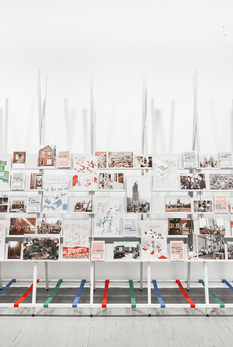
Against the backdrop of the escalating climate crisis, social inequity, and political polarization, the failures of governments or markets to provide even access to resources and opportunities is leading citizens worldwide to take matters into their own hands—self-organizing by pooling resources and claiming their collective right to the city. The creative insights emerging from these practices of commoning offer an entry point for refuting the neoliberal mantra “there is no alternative,” and spurrs the imagination of another possible world. This talk asks many questions, including: What impact can commoning have on the bottom-up transformation of cities? And what agency do designers have in contributing to such commons transition?
Stefan Gruber is an associate professor in architecture and urbanism at Carnegie Mellon University, where he directs the master of urban design program. His work spans design-built projects, and interventions in public space, urban design, and research with a particular focus on spatial practices and the political as articulated through the negotiation of top-down planning and bottom-up transformations of cities. Most recently, Gruber guest-edited ARCH+ magazine 232: An Atlas of Commoning and cocurated the eponymous travelling exhibition. Previous books include Spaces of Commoning (Sternberg, 2016), Big! Bad? Modern (Park Books, 2015) and Vienna: Slow Capital (Academy of Fine Arts Vienna, 2011). Gruber founded STUDIOGRUBER in 2006 after working with Diller, Scofidio + Renfro. His research and design work has been published and exhibited internationally and supported by the Graham Foundation, and fellowships from Margarete Schütte-Lihotzky and Akademie Schloss Solitude, among others.
Image: The travelling ifa-exhibition An Atlas of Commoning on display at the Kunstraum Kreuzberg/Bethaninen in Berlin. Photo: © Sebastian Schels
For more information on the exhibition, Tatiana Bilbao Estudio: Unraveling Modern Living, click here.
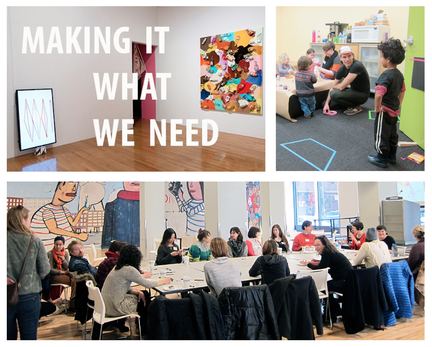
Help create the creative community you'd like to be a part of—in conversation with curators, artists, arts administrators, and others. Making it What We Need is a generative workshop considering alternative models for living, making, and making a living as artists, led by Cultural ReProducers organizer Christa Donner. Non-parents are welcome to join the conversation, which will be relevant to anyone working toward a sustainable life in the arts. Free, on-site childcare will be available through pre-registration.
Christa Donner is an artist, curator, and mother and founder of Cultural ReProducers, who incorporates drawing, participatory performance, and small-press publications to create multi-layered projects that are both intimate and community-centered. Donner’s work is exhibited widely internationally and throughout the United States.
Cultural ReProducers is an evolving group of active cultural workers—artists, designers, curators, musicians, performers, writers, etc.—who are also parents. Founded in 2012 by artist Christa Donner, the group is a creative platform, web resource, and community-based initiative that is for anyone interested in making the art world a more inclusive and interesting place by supporting arts professionals raising kids.
For more information on the exhibition, Tatiana Bilbao Estudio: Unraveling Modern Living, click here.
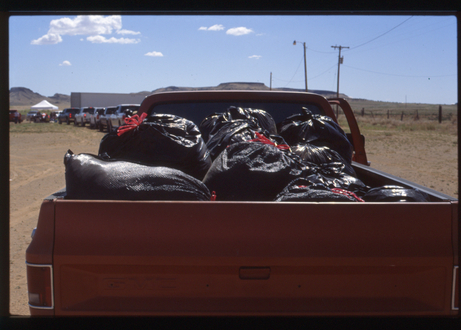
Emily Winter from The Weaving Mill discusses her recent research into domestic wool supply chains, following Navajo-raised wool in its transformation from raw material to the stuff of craft. Starting with its entry to the supply chain at the annual Navajo Nation Wool Buy, through grading, scouring, spinning, and weaving, this project opens up the typically-opaque steps of the supply chain through site visits and interviews. This fieldwork is part of the larger project and ethos of The Weaving Mill, in which consideration of the material, social, and historical contexts that shape the work and operations of the studio is a fundamental piece of the practice itself.
Emily Winter is a weaver based in Chicago. She is co-founder of The Weaving Mill, an experimental weaving studio in Humboldt Park that blends design, fine art, textile education, and research-based practice in the context of a repurposed textile manufacturing facility housed in a day program for adults with developmental disabilities. She has a master’s in textiles from the Rhode Island School of Design and a bachelor’s in history from the University of Chicago.
The Weaving Mill is an experimental weaving studio in Chicago’s Humboldt Park that blends design, fine art, textile education, and research-based practice.
Image: Waiting in line at the Wool Buy, Tuba City AZ, June 2019
For more information on the exhibition, Tatiana Bilbao Estudio: Unraveling Modern Living, click here.
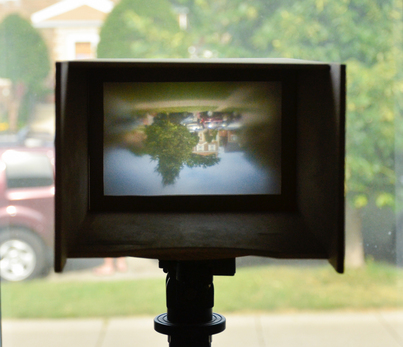
Come explore the Graham Foundation! Participants will be given a diverse range of prompts and sent out to interact with the historic Madlener House and Tatiana Bilbao's exhibition, Unraveling Modern Living. What will you discover? How will you perceive the building? On return from your explorations your tales and impressions will be woven into the broader story of the building and some of Tatiana Bilbao's ideas. This family event is recommended for all ages.
Hui-min Tsen is a photo-based, interdisciplinary artist whose work contemplates the spatial and mental landscapes residing in the gap between Here and There. In projects ranging from walking tours to boat building to works on paper, she uses research and observation to interweave stories of history and the collective imagination with our everyday experience of place and the unknown. Tsen received a BFA from the Tisch School of the Arts, and an MFA from School of the Art Institute of Chicago. She has exhibited and published with the Hyde Park Art Center, Chicago Artist's Coalition, MDW Fair, and Sector 2337, among others. Her book, "The Pedway of Today" was published by Green Lantern Press in 2013. She currently teaches photography at Loyola University.
Image: Courtesy Hui-min Tsen
For more information on the exhibition, Tatiana Bilbao Estudio: Unraveling Modern Living, click here.
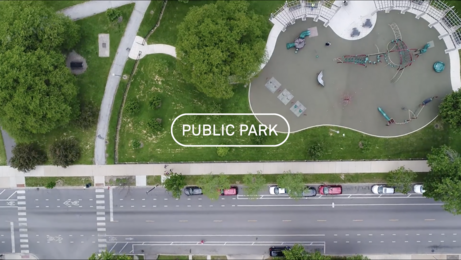
Considering the Chicago Park District network as a platform for cultural life and civic activation that is a unique network of public spaces, this participatory conversation raises questions about the significance, maintenance, and relevance of these civic spaces. With more than 600 parks, 400 field houses, 26 miles of lakefront, 50 outdoor pools, a museum campus, and Soldier Field, today’s Park District operates as a sovereign territory within the city. Multiple and distributed, this territory pervades every ward and neighborhood. Fieldwork asks local and global questions around “publicness”—the complex patterns of individuals and communities, and the systems that organize them. As a network of sites, each park is a polyvalent territory, at once natural, social, psychological, ecological, political, ethnic, historic, and economic. With cultural change, the distribution and structure of the park network faces new demands, and so does the very mythology that grounds it. If these parks were emblematic of Chicago as a city defined by modern industry, later additions to the system—such as Millennium Park—are emblematic of Chicago’s shift to finance, culture, tourism, and lifestyle economies.Through this discussion Fieldwork explores what opportunities emerge if we radically rethink Chicago’s parks.
Fieldwork Collaborative Projects is an interdisciplinary nonprofit dedicated to increasing cultural activity in the Chicago region. Established by artists with backgrounds in architecture, urban planning, anthropology, research, and criticism, the group has extensive experience with curatorial work and institutional administration. By working beyond the confines of the museum or gallery, Fieldwork transforms underutilized spaces traditionally used for sport or recreation by organizing performances, exhibitions, or other unexpected activities to expose the unseen, unconsidered, underestimated or overlooked potential of a particular place.
Nelly Agassi works in performance, installation, video, textile and paper. Her artwork addresses the idea of the body and notion of intimacy within public space in relation to architecture. Her work engages both the personal and emotional as well as universal concepts. Agassi is a 2001 graduate of the MA program of combined media in Chelsea College of Art and Design, London, UK. She has received the Nathan Gottesdiener Foundation for Israeli Art Prize and the Tel Aviv Museum of Art award for artistic encouragement from the Israel Ministry of Science, Culture and Sport. Agassi shown her work extensively throughout the world – in sites such as the Israel Museum, Doritto Rovesscio, Milan Triennial, Poor Farm, USA, Hyde Park Art Center, USA, Terrain Biannial, USA and at the Tate Modern in London.
Ionit Behar is an art historian, curator and critic. She is a Ph.D. candidate in Art History at the University of Illinois at Chicago. Her interests are focused on 20th century Latin American and North American art, the history of exhibitions, sculpture after 1960, and theories of space and place. Behar is interested in the relation between the academic discipline of art history and the practice of museum curating. She holds a Master’s degree in Art History, Theory and Criticism from the School of the Art Institute of Chicago, a Bachelor of Art Theory from Tel Aviv University, and a degree in Art Administration from the Bank Boston Foundation in Montevideo. She is the Curator of Collections and Exhibitions at Spertus Institute for Jewish Learning and Leadership and the Director of Curatorial Affairs for Fieldwork Collaborative Projects NFP (FIELDWORK).
Merav Argov is a graduate of the University of Illinois at Chicago (UIC) in the Urban Planning and Policy Department. She received her Bachelor of Fine Art degree in 1997 from Bezalel Academy of Art and Design, Jerusalem, Israel. She has participated in civic planning and programing in Jerusalem, Tel-Aviv, Jaffa, Amsterdam and Chicago, with insight into urban planning, art installations as well as programing and spatial enterprises. Along with art and environment planning and consultancy, she has worked at Bezalel Public Advocates in Jerusalem, and with the Arabic-Jewish organization for co-existence and democracy in Jaffa. Her works are shown at the Rosenthal Museum in Germany. Argov’s work dealing with the relation between people and their environment has been reviewed and featured in the Haaretz Magazine.
Andrew Schachman designs environments, infrastructures, and installations. He is the executive co-director of two organizations that are experimental spaces for delivering arts and culture within existing metropolitan networks: Floating Museum and Fieldwork Collaborative Projects. Trained as an architect, he designed and managed projects for the offices of Zaha Hadid, Perkins and Will, Carol Ross Barney, and Doug Garofalo. His projects have received numerous awards including the Distinguished Building Award from the American Institute of Architects and the Richard H. Driehaus Foundation Award for Architectural Excellence in Community Design. Principal of Studio Andrew Schachman, he recently completed the design for the Palais de Tokyo’s exhibition, “Singing Stones,” in the roundhouse of the DuSable Museum of African American History. Andrew is a Studio Associate Professor in the College of Architecture at the Illinois Institute of Technology.
For more information on the exhibition, Tatiana Bilbao Estudio: Unraveling Modern Living, click here.
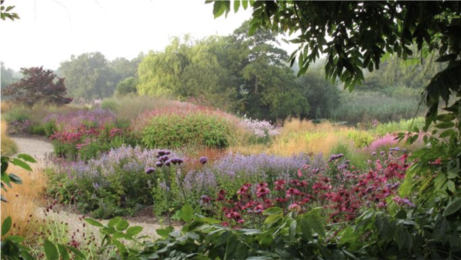
Join us for a screening of Five Seasons: The Gardens of Piet Oudolf, with an introduction by Laura Ekasetya, director and head horticulturalist of Chicago's Lurie Garden. Directed by Thomas Piper, the film immerses viewers in the work of Dutch garden designer Piet Oudolf, giving insight into his creative process from his abstract sketches, to theories on beauty, to the ecological implications of his ideas.
To watch the trailer, click here.
Laura Ekasetya is the director and head horticulturist at the Lurie Garden in Chicago’s Millennium Park where she works to maintain the integrity of Piet Oudolf’s perennial plant design. Laura enjoys stalking insects, birds, and other creatures that make the garden their home and is learning to identify the various birds that migrate through Chicago along the Mississippi Flyway. Laura has a bachelor’s degree in Psychology from Southern Illinois University Edwardsville and studied horticulture at Harold Washington City College of Chicago. Before joining the team at the Lurie Garden in 2017, she tended to perennials grown under research evaluation at the Chicago Botanic Garden.
Lurie Garden in Millennium Park combines naturalistic plantings and ecologically sensitive maintenance practices to create an urban oasis for city dwellers and wildlife alike. The garden offers a four-season experience and pays homage to Chicago’s transformation from flat marshland to a city heralded for investing in extensive green spaces, or “Urbs in Horto” (City in a Garden). Lurie Garden was designed by Gustafson Guthrie Nichol Ltd. and Dutch planting designer Piet Oudolf, and opened in 2004.
For more information on the exhibition, Tatiana Bilbao Estudio: Unraveling Modern Living, click here.
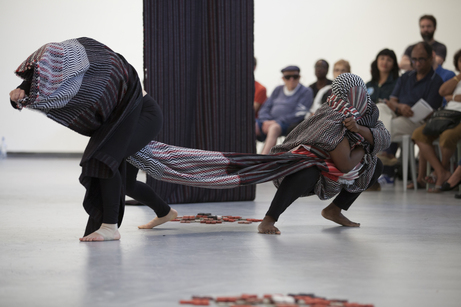
For an afternoon, the Graham Foundation will host an “open rehearsal jam” for Anna Martine Whitehead’s new project Force. Force is a dance opera about queer and trans women of color waiting to get into prison featuring an all qt+ bipoc cast and crew (qt+ = queer and/or trans and/or more; bipoc = black/brown/indigenous/person of color). Force’s open rehearsal will be an opportunity for anyone interested (regardless of background or ability to pick up an instrument) to move their body free from expectation. While this jam will be open to all, queer, trans, and gender nonconforming black, brown, and indigenous folks of color are especially encouraged to come through and take up space.
Anna Martine Whitehead does performance. She has been presented by venues including the Chicago Museum of Contemporary Art; San José Museum of Art; Velocity Dance Center; Chicago Cultural Center; Links Hall; AUNTS; and Yerba Buena Center for the Arts. She has developed her craft working closely with Onye Ozuzu, Jefferson Pinder, taisha paggett, Every house has a door, Keith Hennessy, BodyCartography Project, Julien Prévieux, Jesse Hewit, and the Prison + Neighborhood Art Project, among others. She has been recognized with awards from Portland Institute for Contemporary Art, The Graham Foundation, 3Arts, Chicago Dancemakers Forum, Foundation for Contemporary Arts, Headlands Center for the Arts, Rauschenberg Foundation, and Djerassi. Martine has written about blackness, queerness, and bodies in action for Art21 Magazine, C Magazine, frieze, Art Practical; and has contributed chapters to a range of publications including Queer Dance: Meanings and Makings (Oxford, 2017), Organize Your Own: The Politics and Poetics of Self-Determination Movements (Sobsercove, 2016), Platforms: Ten Years of Chances Dances (2016), and Girl Zines: Making Media, Doing Feminism (NYU, 2009). Martine is the author of TREASURE | My Black Rupture (Thread Makes Blanket, 2016).
Image: Anna Martine Whitehead performance at Hyde Park Art Center in collaboration with Jamie Hayes/Production Mode, 2017. Photo: Sarah Pooley
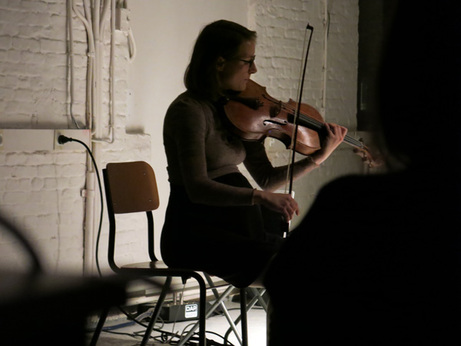
Catherine Lamb is a violist and composer who blends West Coast experimentalism with the structures and intonations of ancient Hindustani music. Her music reveals a slow-changing spectrum of microtonal colors and temporal effects, in stunning works that explore the interaction of sounds in specific physical spaces or rooms.
Lamb and frequent collaborator Rebecca Lane (bass flute/voice) will perform Prisma Interius IV with special guest Olivia Block. The piece is the fourth in a series of nine works constructed around the Secondary Rainbow Synthesizer, an instrument that spectrally filters live sound picked up from microphones outside.
“The intent is to extend the harmonic space and shapes occurring in the musical piece (defined by the acoustic instrumentalists in the room) to discover the edges of our listening perceptions, by pulling an infinite thread to it,” Lamb writes.
This is Lamb's Chicago debut and Lane's first U.S. performance.
Catherine Lamb is a composer and performer interested in how precise frequencies of pitch interact harmonically and sonically. She has been studying and composing music since a young age. In 2003 she turned away from the conservatory in an attempt to understand Hindustani classical music, later finding Mani Kaul in 2006. She also studied experimental composition at the California Institute of the Arts under James Tenney and Michael Pisaro, who were both integral influences. It was during this time that she began diving deeply into her own practice of what she later termed “the interaction of tone.”
Lamb is the co-founder of Singing by Numbers (2009-11), an experimental vocal ensemble formed with Laura Steenberge. She has written for ensembles such as Ensemble Dedalus, Konzert Minimal, the London Contemporary Orchestra, NeoN, Plus/Minus, and Yarn/Wire. Lamb is involved in ongoing research with Marc Sabat on intonation; with Johnny Chang on Viola Torros; develops work regularly with musicians such as Rebecca Lane, Dafne Vincente-Sandova, and Frank Reinecke; as well as taking part in Triangulum with Julia Holter and Laura Steenberge.
She is the recipient of an Emerging Composers Award from the Wallace Alexander Gerbode and William and Flora Hewlett Foundations for Dilations (2008-09); a travel grant from the Henry Cowell Foundation, allowing her to pursue work with Eliane Radigue (2012); a fellowship from Akademie Schloss Solitude (2016); was a Staubach Fellow at the International Summer Course for New Music in Darmstadt (2016); and received the Grants to Artists award from the Foundation for Contemporary Arts (2018). Her writings and recordings have been published by Another Timbre, Black Pollen Press, Kunst Musik, NEOS, Open Space Magazine, Q-O2, Sacred Realism, Sound American and Winds Measure. She graduated from CalArts in 2006 and received her MFA from Bard College in 2012. Lamb lives in Berlin, Germany.
Rebecca Lane is a Berlin-based musician who investigates sounds on the edge of perception, focusing on the experiential qualities of sound, but also on phenomena that only emerge through particular ways of working together. Thus, her practice is informed by ongoing collaborations with like-minded artists, including Catherine Lamb, Marc Sabat and Clara de Asís, among others, and within small ensembles, using various flutes (flute, quarter-tone bass flute, recorders) and voice.
Artist Talk: Ahead of her performance, Catherine Lamb presents a new performative lecture. In The Form of the Spiral, she draws something other than a straight line from artists like James Tenney and Maryanne Amacher, to things she has learned from Dhrupad, an ancient style of Hindustani classical music, making connections with her own recent work. Lampo Annex, Monadnock Building, 53 W. Jackson Blvd. #1656. Friday, December 13, 6pm. FREE; CLICK HERE TO RSVP VIA LAMPO
Supported by the Farny R. Wurlitzer Foundation Fund
Since 2010 the Graham Foundation has supported and partnered with Lampo to produce this performance series held at the Madlener House. Lampo, founded in 1997, is a non-profit organization for experimental music and intermedia projects.
Unless otherwise noted,
all events take place at:
Madlener House4 West Burton Place, Chicago
GALLERY AND BOOKSHOP HOURS
2025 Chicago Architecture Biennial
SHIFT: Architecture in Times of Radical Change
Sep 19, 2025–Feb 28, 2026
Wed–Sat, 12–5 p.m.
CONTACT
312.787.4071
info@grahamfoundation.org
Accessibility
Events are held in the ballroom on the third floor which is only accessible by stairs.The first floor of the Madlener House is accessible via an outdoor lift. Please call 312.787.4071 to make arrangements.
Copyright © 2008–2025 Graham Foundation. All rights reserved.